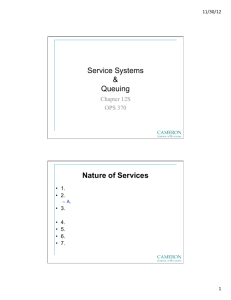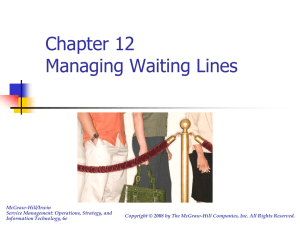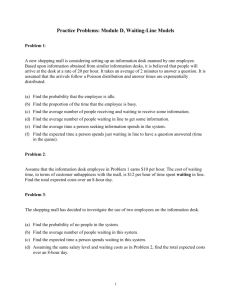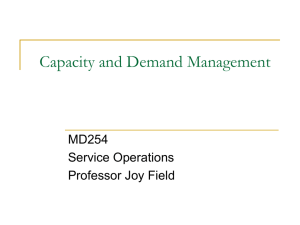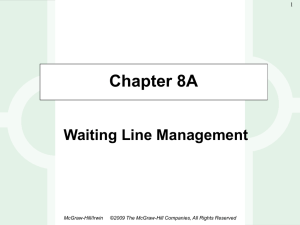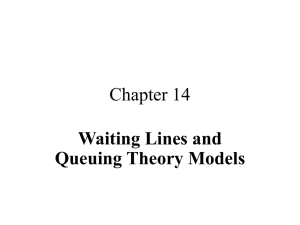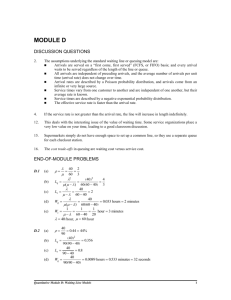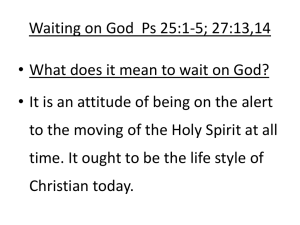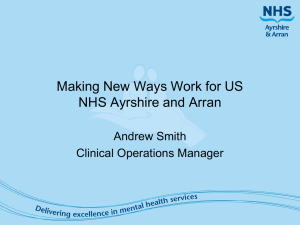WLNOTES
advertisement
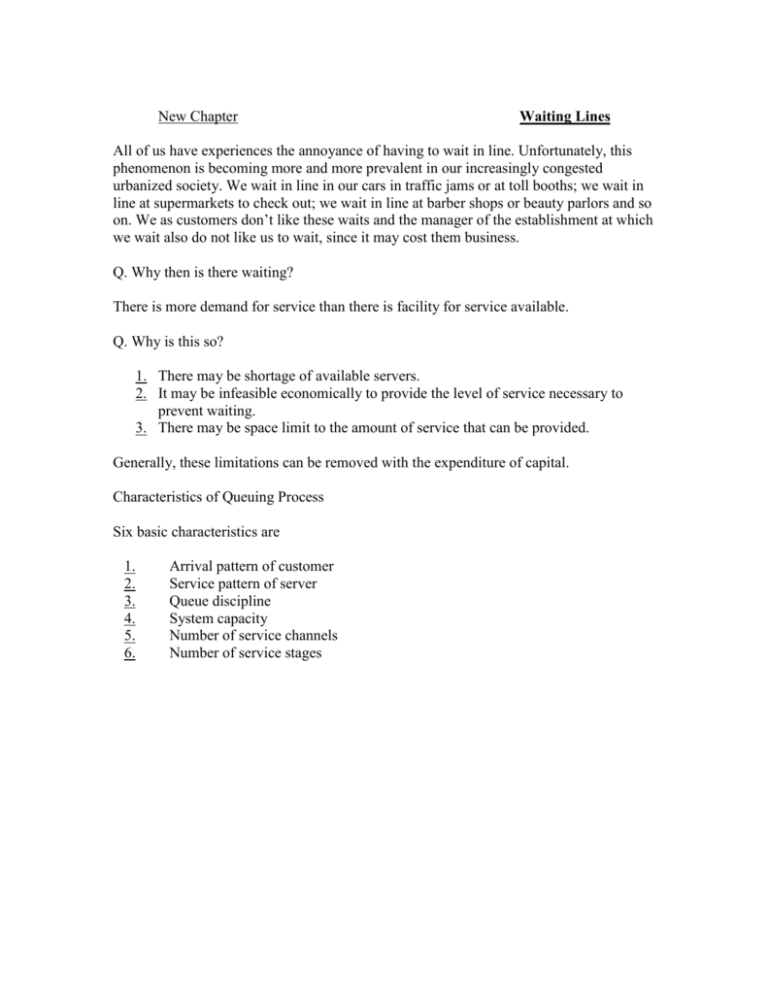
New Chapter Waiting Lines All of us have experiences the annoyance of having to wait in line. Unfortunately, this phenomenon is becoming more and more prevalent in our increasingly congested urbanized society. We wait in line in our cars in traffic jams or at toll booths; we wait in line at supermarkets to check out; we wait in line at barber shops or beauty parlors and so on. We as customers don’t like these waits and the manager of the establishment at which we wait also do not like us to wait, since it may cost them business. Q. Why then is there waiting? There is more demand for service than there is facility for service available. Q. Why is this so? 1. There may be shortage of available servers. 2. It may be infeasible economically to provide the level of service necessary to prevent waiting. 3. There may be space limit to the amount of service that can be provided. Generally, these limitations can be removed with the expenditure of capital. Characteristics of Queuing Process Six basic characteristics are 1. 2. 3. 4. 5. 6. Arrival pattern of customer Service pattern of server Queue discipline System capacity Number of service channels Number of service stages System 1 and 2 are shown below; what type of systems are they The figure below depicts system #3 what type of Waiting line is this Notations for classification of waiting line models D.A. Kendall suggested a notation that is helpful in classifying waiting line models. The 3 symbol Kendall notation is A/B/K A → denotes the probability distribution for the arrival B → denotes the probability distribution for the service time K → denotes the number of channels or S Letters which can appear in the A or B position are M → designates a Poisson probability distribution for the arrivals or exponential probability distribution for service time. D → means that arrival or service time are determinants or constant. G → means that the arrival or the service time has a general probability distribution with a known mean and variance. In addition to these three notations three other notations may be added to complete the model A/B/K : (4/5/6) Where the 4 → denotes the size of the population 5 → denotes the largest number of units that can be in the system. 6 → indicates the queue discipline example FCFS We will be dealing with FCFS (First Come First Serve) steady state systems only. At times if (4/5/6) symbols are not mentioned that means the capacity of the system is infinite and the population is assumed to be infinite. Imp → For solving any waiting line problem it is important to understand which model will apply to it Representation of single channel waiting line 1. (M/M/1) : (∞/∞/FCFS) → Single channel waiting line model with poisson arrivals and exponential service times with infinite calling population/infinite system capacity if the queue display is first come first served λ = mean arrival rate of customers μ = mean service rate 2. (M/M/K) : (∞/∞/FCFS) K = channels/servers (more than one so) multiple channels 1st M = poisson arrivals 2nd M = exponential service time ∞ = infinite calling population ∞ = infinite system capacity FCFS = queue discipline First Come First Serve In this type of model the service channels, which are 2 or more, are assumed to be identical in terms of service capabilities. * μ = mean service rate is the same for each channel * The arrivals wait in a single waiting line and then move to the first open channel for service. This model can also be denoted M/M/K or M/M/S where K or S means number of servers and (∞/∞/FCFS) is understood. λ = mean arrival rate for the system μ = mean service rate for each channel (servers) k = number of channels (servers) 3. (M/G/I) we will do M/G/ 1 M = poisson arrival rate G = arbitrary service time with mean and standard deviation of the service time known I = no of servers or channels is ‘one’ Single channel waiting line models with ‘poisson’ arrivals and arbitrary service times. λ = mean arrival rate μ = mean service rate σ = standard deviation of the service time 4. M/D/I we will do M/ constant/1 Where D = constant service time This model has resemblance with M/G/I model in the sense that if σ = 0 ie the standard deviation is zero then the formulae used for M/G/I model can be used for this model. Lq = (λ/μ)2 2(1- λ/μ) 5 rest are same as (M/G/I) model M/M/1 models with finite calling population. For the waiting line models introduced so far, the populations of units or customers arriving for service has been considered to be unlimited. There are certain cases when the maximum number of units or customers that may seek service is assumed to be finite. In this situation mean arrival rate for the system changes depending on the number of units in the waiting line. λ = mean arrival rate μ = mean service rate N = the size of the population 6 M/M/1 models with finite system capacity. Operating Characteristics of Waiting Line Model λ = mean arrival rate, μ = mean service rate 1. Po = Probability that no units are in the system 2. Lq = Average number of units in the waiting line 3. L = Average number of units in the system 4. Wq = Average time a unit spends in the waiting line 5. W= Average time a unit spends in the system 6. Pw = Probability that the arriving unit has to wait for service 7. Pn = Probability of ‘n’ units in the system K= number of servers Utilisation factor = λ/μ μK > λ Economic Analysis of Waiting Lines One of the most complicated issues in designing a waiting line system is deciding adequate level of service. At times it can be arbitrarily set at say 2mts of waiting time etc. On the other hand manager may want to do cost analysis and go with the design with lowest total cost. Total cost has two compounds, viz 1. Cost of providing service this cost includes the wages of the worker (service provider) and any fixed costs or costs of infrastructure etc. 2. Cost of waiting: - It is a rather difficult figure to attain nevertheless it can be done. The basis behind this cost is the potential loss of business because of waiting time. Let us take a hypothetical situation where ‘Jack’ stopped using services of Mcdonalds as their waiting time was higher * and started using the services of Burger King. * (higher with respect to his expectations) TC = CWL + CSK Where TC = Total Cost Cw = waiting cost per time period for each unit L = the average number of units in the system CS = the service cost per time period for each channel K = the number of channels Distribution of Arrivals For many waiting line situations the arrivals occur randomly and independently of other arrivals and we cannot predict when an arrival will occur. In this case Poisson Probability distributions provides a good descriptions of arrival pattern. P(x) = λxe-λ x! for x = 0,1,2…. x = the number of arrivals in the time period λ = mean number of arrivals per time period e = 2.71828
